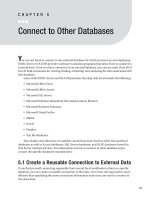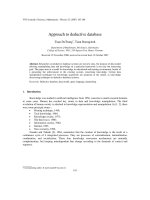Introduction to mobile data
Bạn đang xem bản rút gọn của tài liệu. Xem và tải ngay bản đầy đủ của tài liệu tại đây (2.07 MB, 40 trang )
Introduction to Mobile Data
Circuit Switched, Packet Switched, Mobitex, CDPD, and GPRS
Lawrence Harte
Excerpted From:
Wireless Systems
With Updated Information
ALTHOS Publishing
Packet Switched Data
TCP/IP Protocol
Information Services
General Packet Radio
Service (GPRS)
ALTHOS Publishing
Copyright © 2004 by the ALTHOS Publishing Inc. All rights reserved. Produced in the
United States of America. Except as permitted under the United States Copyright Act of
1976, no part of this publication may be reproduced or distributed in any form or by any
means, or stored in a database or retrieval system, without prior written permission of the
publisher.
ISBN: 0-9746943-9-8
All trademarks are trademarks of their respective owners. We use names to assist in the
explanation or description of information to the benefit of the trademark owner and ALTHOS
publishing does not have intentions for the infringement of any trademark.
ALTHOS electronic books (ebooks) and images are available for use in educational, promo-
tional materials, training programs, and other uses. For more information about using
ALTHOS ebooks and images, please contact Karen Bunn at or (919) 557-
2260
Terms of Use
This is a copyrighted work and ALTHOS Publishing Inc. (ALTHOS) and its licensors reserve
all rights in and to the work. This work may be sued for your own noncommercial and per-
sonal use; any other use of the work is strictly prohibited. Use of this work is subject to the
Copyright Act of 1976, and in addition, this work is subject to these additional terms, except
as permitted under the and the right to store and retrieve one copy of the work, you may not
disassemble, decompile, copy or reproduce, reverse engineer, alter or modify, develop deriva-
tive works based upon these contents, transfer, distribute, publish, sell, or sublicense this
work or any part of it without ALTHOS prior consent. Your right to use the work may be ter-
minated if you fail to comply with these terms.
ALTHOS AND ITS LICENSORS MAKE NO WARRANTIES OR GUARANTEES OF THE
ACCURACY, SUFFICIENCY OR COMPLETENESS OF THIS WORK NOR THE RESULTS
THAT MAY BE OBTAINED FROM THE USE OF MATERIALS CONTAINED WITHIN
THE WORK. APDG DISCLAIMS ANY WARRANTY, EXPRESS OR IMPLIED, INCLUDING
BUT NOT LIMITED TO IMPLIED WARRANTIES OF MERCHANTABILITY OR FITNESS
FOR A PARTICULAR PURPOSE.
ALTHOS and its licensors does warrant and guarantee that the information contained with-
in shall be usable by the purchaser of this material and the limitation of liability shall be lim-
ited to the replacement of the media or refund of the purchase price of the work.
ALTHOS and its licensors shall not be liable to you or anyone else for any inaccuracy, error
or omission, regardless of cause, in the work or for any damages resulting there from.
ALTHOS and/or its licensors shall not be liable for any damages including incidental, indi-
rect, punitive, special, consequential or similar types of damages that may result from the
attempted use or operation of the work.
-ii-
Copyright ©, 2004, ALTHOS, Inc
-iii-
Copyright ©, 2004, ALTHOS, Inc
About the Author
Mr. Harte is the president of Althos, an expert information
provider covering the communications industry. He has over
29 years of technology analysis, development, implementation,
and business management experience. Mr. Harte has worked
for leading companies including Ericsson/General Electric,
Audiovox/Toshiba and Westinghouse and consulted for hun-
dreds of other companies. Mr. Harte continually researches,
analyzes, and tests new communication technologies, applications, and ser-
vices. He has authored over 30 books on telecommunications technologies on
topics including Wireless Mobile, Data Communications, VoIP, Broadband,
Prepaid Services, and Communications Billing. Mr. Harte’s holds many
degrees and certificates include an Executive MBA from Wake Forest
University (1995) and a BSET from the University of the State of New York,
(1990).
-iv-
Copyright ©, 2004, ALTHOS, Inc
-v-
Copyright ©, 2004, ALTHOS, Inc
Table of Contents
INTRODUCTION TO
MOBILE DATA . . . . . . . . . . . . . . . . . . . . . . . . . . . . 1
M
ARKET DECLINE AND GROWTH . . . . . . . . . . . . . . . . . . . . . . . . . . . . 3
TECHNOLOGIES . . . . . . . . . . . . . . . . . . . . . . . . . . . . . . . . . . . . . . . . 4
Circuit Switched Data . . . . . . . . . . . . . . . . . . . . . . . . . . . . . . . .4
Packet Switched Data . . . . . . . . . . . . . . . . . . . . . . . . . . . . . . . . .6
Sub-Band Data Transmission . . . . . . . . . . . . . . . . . . . . . . . . . .8
Shared Voice and Data . . . . . . . . . . . . . . . . . . . . . . . . . . . . . . .10
Wireless Modem Protocols . . . . . . . . . . . . . . . . . . . . . . . . . . . . .11
Modem Pools . . . . . . . . . . . . . . . . . . . . . . . . . . . . . . . . . . . . . . .12
Internet Protocols . . . . . . . . . . . . . . . . . . . . . . . . . . . . . . . . . . .12
General Packet Radio Service (GPRS) . . . . . . . . . . . . . . . . . . .14
W
IRELESS DATA APPLICATIONS . . . . . . . . . . . . . . . . . . . . . . . . . . . . 15
Credit Card Devices . . . . . . . . . . . . . . . . . . . . . . . . . . . . . . . . .16
Parking Meters . . . . . . . . . . . . . . . . . . . . . . . . . . . . . . . . . . . . .16
Vending . . . . . . . . . . . . . . . . . . . . . . . . . . . . . . . . . . . . . . . . . . .17
Environmental Monitoring . . . . . . . . . . . . . . . . . . . . . . . . . . . .18
Energy Management . . . . . . . . . . . . . . . . . . . . . . . . . . . . . . . . .18
Dispatch . . . . . . . . . . . . . . . . . . . . . . . . . . . . . . . . . . . . . . . . . .18
Utility Monitoring . . . . . . . . . . . . . . . . . . . . . . . . . . . . . . . . . . .19
Wireless E-mail . . . . . . . . . . . . . . . . . . . . . . . . . . . . . . . . . . . . .19
Wireless Internet . . . . . . . . . . . . . . . . . . . . . . . . . . . . . . . . . . . .19
Mobile Computing . . . . . . . . . . . . . . . . . . . . . . . . . . . . . . . . . . .20
Advertising . . . . . . . . . . . . . . . . . . . . . . . . . . . . . . . . . . . . . . . .20
Vehicle Monitoring Services . . . . . . . . . . . . . . . . . . . . . . . . . . .21
C
OMMERCIAL MOBILE DATA SYSTEMS . . . . . . . . . . . . . . . . . . . . . . . 21
Data over Cellular . . . . . . . . . . . . . . . . . . . . . . . . . . . . . . . . . .21
DataTACTM . . . . . . . . . . . . . . . . . . . . . . . . . . . . . . . . . . . . . . .22
Mobitex . . . . . . . . . . . . . . . . . . . . . . . . . . . . . . . . . . . . . . . . . . .23
Cellular Digital Packet Data (CDPD) . . . . . . . . . . . . . . . . . . . .23
-vi-
Copyright ©, 2004, ALTHOS, Inc
Cellemetrysm . . . . . . . . . . . . . . . . . . . . . . . . . . . . . . . . . . . . . . .24
Aeris Microburst . . . . . . . . . . . . . . . . . . . . . . . . . . . . . . . . . . . .25
Teletrac . . . . . . . . . . . . . . . . . . . . . . . . . . . . . . . . . . . . . . . . . . .26
Ricochet . . . . . . . . . . . . . . . . . . . . . . . . . . . . . . . . . . . . . . . . . . .26
FM Sub-band Signaling . . . . . . . . . . . . . . . . . . . . . . . . . . . . . .27
S
ERVICES . . . . . . . . . . . . . . . . . . . . . . . . . . . . . . . . . . . . . . . . . . . . 27
Circuit Switched Data . . . . . . . . . . . . . . . . . . . . . . . . . . . . . . .27
Packet Data . . . . . . . . . . . . . . . . . . . . . . . . . . . . . . . . . . . . . . . .29
Wireless Messaging . . . . . . . . . . . . . . . . . . . . . . . . . . . . . . . . . .30
FUTURE ENHANCEMENTS
. . . . . . . . . . . . . . . . . . . . . . . . . . . . . . . . 31
High-Speed Packet Data . . . . . . . . . . . . . . . . . . . . . . . . . . . . . .31
Introduction to Mobile Data
-1-
Copyright ©, 2004, ALTHOS, Inc
Introduction to Mobile
Data
Mobile data is the transmission of digital information, through a wireless
network, to radios that can typically move throughout a relatively large geo-
graphic area. The success of mobile wireless data systems had been limited,
until the mid 1990’s, due to the high cost of service and equipment, and lim-
ited geographic coverage areas. In the mid 1990’s, service usage and equip-
ment costs dropped due to competition and availability of applications and
end user devices. Many wireless data systems are now available globally.
In addition to the mobile wireless data systems covered in this chapter,
there are also many types of short-range wireless data systems. These sys-
tems include wireless local loop (WLL), wireless local area network (WLAN)
and wireless cable. These short rage wireless systems are covered in chap-
ter 9 and chapter 12.
The growth of the Internet has also enabled low cost, standardized access to
wireless data networks that is accelerating the growth of the wireless data
marketplace. In 2003, some dedicated wireless data systems had more then
15 million devices operating in their system (CNET provides wireless elec-
tric utility monitoring service).
Introduction to Mobile Data
-2-
Copyright ©, 2004, ALTHOS, Inc
Figure 1.1 shows a basic mobile wireless data system. In this system, many
types of wireless data devices (mobile data terminals) communicate to near-
by base station transmitters using a radio protocol that is unique to this sys-
tem. A packet switch is used to route the packets between mobile data ter-
minals or through a gateway that connects the mobile data system to the
Internet. The packet switch is connected to a subscriber database that is
used to determine which services are authorized, where the customer is
located (location register), and the amount of services that the customer has
used. This diagram shows that base station transmitters typically provide
more transmitter power (50 Watts in this example) than the mobile data ter-
minals (2 Watts in this example.)
Figure 1.1, Mobile Wireless Data System <ag_mobile_ data_system>
Introduction to Mobile Data
-3-
Copyright ©, 2004, ALTHOS, Inc
Market Decline and Growth
Wide area mobile data systems are transitioning from narrowband (low-
speed) mobile data to shared (mobile telephone voice and data) mobile com-
munication system. This transition can be confusing as some of the tradi-
tional mobile data applications such as wireless credit card machines can
now operator using a different type of wireless system.
To date, most mobile data applications are non-human in nature and
require small amounts of data transfer. The key mobile data applications
include monitoring vending machines, utility measurement, providing road
sign information, security system, environmental measurements, wireless
credit card machines, and hundreds of other applications. Mobile data appli-
cations that require human interaction (such as email) are transitioning
from low speed data systems to high-speed mobile telephone systems.
Figure 1.2 shows the growth rate for packet based wireless data services.
This diagram shows the dramatic increase of GSM mobile data users from
2002 through 2003.
Figure 1.2, Wireless Data Market Growth
Source: EMC Word Cellular Data
Technologies
There are several wireless technologies that are used for mobile wireless
data. These technologies allow data rates to vary from a few kilobytes per
second to several hundred kilobytes per second.
Wireless data technology is commonly divided into two types of transmis-
sion: circuit switched data and packet switched data. Circuit switched data
is characterized by the continuous connection between two points. Packet
data is identified by the dividing of data into small packets that may take
different routes between points.
There is a new type of wireless data called “control channel data. Control
channel technology utilizes the excess capacity of a wireless system control
channel to transmit packets or burst of data. While this technology is usu-
ally limited to small amounts of data (a few hundred bytes per message),
existing systems can have good coverage area and it is relatively inexpen-
sive to upgrade the existing system to provide mobile data services.
Circuit Switched Data
Circuit switched data is the continuous transfer of data between two points.
To establish a circuit switched data connection, the connection address (nor-
mally a phone number) is sent first and a connection path is established.
After this path is setup, data is continually transferred using this path until
the path is disconnected by request from the sender or receiver of data.
Circuit switched data would be understood better if it was entitled “A phone-
call for data” because a connection (usually a public telephone call) must be
made beforehand. After the phone call is connected through the public
switched telephone network (like most modems do on home computers), the
telephone circuit remains in conversation mode while data is transmitted
back and forth between the two devices. For circuit switched data, the tele-
phone circuit resources (wires and switching) remain dedicated to (and typ-
ically paid for by) the user regardless if data transmission has stopped.
Introduction to Mobile Data
-4-
Copyright ©, 2004, ALTHOS, Inc
Introduction to Mobile Data
-5-
Copyright ©, 2004, ALTHOS, Inc
Figure 1.3 shows a circuit switched data system. In this figure, a computer
is sending a data file through a circuit switched data communications net-
work to a home office computer. To start the data file transfer, the comput-
er sends the destination address (address 202.196.22.45) to the data net-
work. The destination address is used to program the switches between the
points on which ports they will receive the data and which ports they will
send the data. As soon as all the switching connections are made, the com-
puter can start sending data to the office. Throughout the connection, this
path will be maintained through the initial path (the same switch ports)
without any changes.
Figure 1.3, Circuit Switched Data
Introduction to Mobile Data
-6-
Copyright ©, 2004, ALTHOS, Inc
Packet Switched Data
Packet switch data is the transfer of information between two points
through the division of the data into small packets. The packets are routed
(switched) through the network and reassembled at the other end to recre-
ate the original data. Each data packet contains the address of its destina-
tion. This allows each packet to take a different route through the network
to reach its destination.
Packet data is ideally suited for information services that have short bursty
(i.e., the data transfer occurs only during a small amount of the time – in
“bursts” – while most of the time there is no data transfer required) com-
munication requirements. The primary advantages of packet data trans-
mission include rapid connection time and efficient use of resources for short
data transmission requirements. The disadvantages of packet systems
include inefficiency due to the inclusion of an address message with each
packet of data and unpredictable delays associated with transmission.
Unlike circuit switched communication that keeps a communication chan-
nel in use regardless if data information is temporarily halted (such as
browsing the web), packet data systems only transmit when there is infor-
mation to be sent. The packet data system does not maintain a constant con-
nection between the two users. This type of system is referred to as “con-
nectionless” because there are no pre-determined time periods or dedicated
resources for packet transmission.
Packet switched systems divide a customer’s data information into small
packets that contain their destination address. Packets are sent to their des-
tination by the best path possible at the time of transfer. The travel time for
each packet between its origin and destination may be different. This is
because packets of information are often sent on different routes due to com-
munications path availability. As packets are received, they are reassem-
bled in the proper order at the receiving end.
Introduction to Mobile Data
-7-
Copyright ©, 2004, ALTHOS, Inc
Figure 1.4 shows the basic operation that uses packet-switched data. In this
example, a laptop computer is sending a file to a company’s remote comput-
er that is connected to a packet data network. The laptop computer data
communication software requests the destination address for the packets for
the user to connect to the remote computer (202.196.22.45). In this example,
the source computer divides the data file into three parts and adds the pack-
et address to each of the 3 data packets. The packets are sent through
routers in the packet network that independently determine the best path
at the time that will help the packet reach its destination (smart switches).
This diagram shows the three packets take 3 different routes to reach their
destination. When the 3 packets reach their destination, the remote com-
puter reassembles the data packets into the original data file.
Figure 1.4, Packet Switched Data
The question of choice between using circuit switched data and packet
switched data is often an easy one, but the choice may not be predicated
totally upon technological capabilities. In the applications where communi-
cation is continuous and loaded with data transfer - circuit switched data is
the choice. An example of an appropriate circuit-switched application would
be continuous data file transfer. Connection to email is an example of an
application that is well suited to packet switched data, because the majori-
ty of time is spent standing by to send or receive email. Field service dis-
patch and courier pick-up & delivery are also examples of when packet data
would be the appropriate application choice. All use short bursty messages,
1 or 2 packets out and in per transaction. In the real world, even though an
application may be suited for a certain technology, availability, standards
compliance or good marketing campaigns often make the decision for the
public.
Research has shown that wireless data applications are solutions oriented,
not technology based. The solution may be a combination of price, technolo-
gy, and application, and the bottom-line decision will not be based on tech-
nology. The solution should solve a specific problem.
Recent reductions in pricing for wireless data service combined with easier
interfacing with the Internet have drastically altered the price based deci-
sion making process between circuit and packet. Some carriers have
announced unlimited (“all you can eat”) wireless data service plans that
make the decision to go with packet much easier to justify. With circuit data
being charged by the minute and packet data offering a fixed rate, the pri-
mary decision becomes not price but coverage.
Sub-Band Data Transmission
Sub-band wireless data transmission involves the sending of data signals
with other radio signals, such as radio or television broadcast channels,
through a radio control channel. Sub-band data transmission takes advan-
tage of the unused capacity of a radio channel and the large geographic cov-
erage area of high power radio stations. One of the key advantages of sub-
band or control channel data transmission is the limited amount of system
investment. Most sub-band data transmission systems only require an
Introduction to Mobile Data
-8-
Copyright ©, 2004, ALTHOS, Inc
Introduction to Mobile Data
-9-
Copyright ©, 2004, ALTHOS, Inc
update to the switch or network head end. Once this is accomplished, the
control channel data service is available throughout the area serviced by
that system. There is no additional requirement to upgrade each radio
transmission tower equipment.
Figure 1.5 shows how a radio channel is used to send data information along
with a radio broadcast signal. In this example, a data signal is combined
with a radio broadcast studio signal and they are sent to the high power
radio transmission tower. The sub-band audio signal is shifted in frequency
so that listeners to the audio broadcast signal do not hear the sub-band data
signal. Devices such as pagers, road signs and smart cars have special
receivers that can separate the data signal from the audio broadcast signal.
Figure 1.5, Sub-Band Data System
Introduction to Mobile Data
-10-
Copyright ©, 2004, ALTHOS, Inc
Shared Voice and Data
Shared voice and data systems allow data transmission on radio channels
when voice communication is not in process. The concept of shared voice and
data allows a voice system to offer data services during idle radio channel
periods.
Figure 1.6 shows the basic operation of a wireless communication system
that allows for shared voice and data transmission. The wireless data device
scans radio channels (step 1) for a free one. After it has found and locked
onto a free radio channel, it will begin to transmit data (step 2). If the radio
channel is interrupted by another activity (such as a voice signal), the wire-
less data device will re-tune to the next available wireless data radio chan-
nel and continue to send data. This technique treats the radio channels that
have voice activity (voice sessions) as noise. This is an example of the fre-
Figure 1.6, Shared Voice and Data System
Introduction to Mobile Data
-11-
Copyright ©, 2004, ALTHOS, Inc
quency hopping technique described earlier. The important point here is
that voice is treated as the superior application. If voice has the channel, the
wireless data system looks elsewhere for an unoccupied radio channel. If the
channel is quiet, the data hops on. If data is active and another voice session
comes up, the data hops again. This is possible since the data is operating
in packet mode. The packets can be reassembled at the receiving end no
matter which air channel is used.
Wireless Modem Protocols
Modem protocols are the language that modems use to communicate with
each other. Modems convert digital signals (normally from a computer) into
audio signals that can be sent through a network (usually the telephone net-
work). In addition to the conversion of user data signals to audio signals,
modems communicate with each other using protocol language.
The protocol language used by landline modems and data communication
systems are typically different than the protocols used by wireless modems.
Landline modem communication protocols are optimized for communication
paths that usually have consistent quality or a limited number of bit errors.
Radio modem protocols are optimized to adapt to the different types of dis-
tortions that may occur on a radio channel.
It is possible for standard modems to communicate through radio channels
(such as cellular). However, if the radio channel experiences distortion, this
will result in difficulty transmitting and may even result in a lost data con-
nection. When using a radio channel for data communication, it is best to
use modems with the protocols that have been optimized for radio trans-
mission. Even with the use of modems that are specifically designed for
radio transmission, a realistic wireless data transfer rate (throughput) is
approximately 9600 bps. Cellular capable modems regularly have 28,800 or
even 56K stamped all over them, but those rates are only apply when the
modem is being used on a wireline connection [
1
].
Introduction to Mobile Data
-12-
Copyright ©, 2004, ALTHOS, Inc
Mobile data systems adapt the radio protocols (protocol adaptation) to the
protocols that are used in the landline or data communication network. This
process may involve syntax changes (text format and command name
changes,) timing relationships, and other functional processes.
Modem Pools
Modem pools are the inter-working functions between a mobile radio modem
and a wired telephone modem. Modem pools contain equipment that convert
radio modem protocols to wired telephone modem protocols. A wireless sys-
tem must coordinate the selection of which modems will be selected in the
modem pool.
A wireless system may include modem pools that adapt wireless data
modem protocols to standard telephone protocols. To access a modem pool,
a mobile radio must first connect to the wireless network and request a
modem for digital service. For some systems, such as the GSM system, this
is a message that is sent from the mobile phone that requests for the call to
be processed as a data call through a modem. For other systems that cannot
send such messages (such as analog cellular networks), the user must dial a
special phone number that routes the call to a modem pool. After the con-
nection is established, the mobile phone then dials the destination number
for the modem to be connected. After the connection is established, the radio
modem communicates with the modem in the modem pool. The modem in
the modem pool then converts the information to the selected landline
modem format.
Internet Protocols
The Internet uses Transaction Capability Protocol/Internet Protocol
(TCP/IP), which is the fundamental language of the Internet. While TCP/IP
is a universal standard for Internet communications, it uses a large portion
of the data transmitted for signaling. Because the amount of available data
in a wireless data system is usually limited and has higher costs associated
with it, many wireless data systems do not directly use TCP/IP. They usu-
Introduction to Mobile Data
-13-
Copyright ©, 2004, ALTHOS, Inc
ally have protocol adapters that allow the conversion of their proprietary
protocol to TCP/IP protocol. This allows most wireless data systems to offer
interconnection to the Internet (while keeping the airlink usage to a mini-
mum).
Figure 1.7 shows how transaction control protocol (TCP) operates to reliably
send data through a packet network. This diagram shows that the TCP sys-
tem receives the data from a specific communication port (port number). The
TCP system then packetizes (divides) the sender’s data into smaller packets
of data (maximum 1500 bytes). Each of these packets starts with an IP
header that contains the destination address of the packet. The TCP system
then adds a second header (the TCP control header) that includes a
sequence number along with other flow control information. The packets are
sent through the system where they may be received at different time peri-
ods. The sequence numbers can be used to reorder the packets. The TCP
protocol also includes a window size that indicates to the receiving device
Figure 1.7, TCP Protocol Operation
Introduction to Mobile Data
-14-
Copyright ©, 2004, ALTHOS, Inc
how many packets it can receive before it must acknowledge their receipt.
This window defines how much data the sending device must keep in tem-
porary memory to enable the retransmission of a packet in the event that a
packet is lost in transmission. If a packet is lost, the receiving device
requests the transmitting device to re-send the packet with a specific
sequence number.
General Packet Radio Service (GPRS)
GPRS is a portion of the GSM cellular system industry specification that
allows packet data transmission service on the GSM cellular system. The
GPRS system adds (defines) new packet control channels and gateways to
the GSM system. The maximum data transmission rate of the GPRS system
is 172 kbps.
Figure 1.8 shows some of the key GPRS network elements that include a
gateway GPRS support node (GGSN), a serving GPRS support node (SGSN)
and a GPRS backbone network (the Internet in this example.) This example
shows that the GPRS system adds dynamic time slot control to the standard
GSM radio system. To provide packet data service, the GPRS system, the
SGSN provides the processes of switching and access control that is similar
to a mobile switching center (MSC) and a visitor location register (VLR).
However, the SGSN provides for switching and access control (authorization
and tracking) based on packets of data rather than continuous connections.
The SGSN registers and maintains a list of active packet data radios in its
network and coordinates the packet transfer between the mobile radios. The
GGSN is a packet switching system that is used to connect a GSM mobile
communication network (GPRS Support Nodes) to other packet networks
such as the Internet.
Wireless Data Applications
Wireless data is used for thousands of unique applications. Most wireless
data applications are primarily narrow vertical market applications that
offer specific solutions. Wireless data services vary from low data rate
mobile applications to high-speed data for fixed location applications.
Applications can be divided into vertical (industry specific) and horizontal
(mass market) types. Historically, wireless data services have been used for
the business community in vertical applications. In the mid 1990’s, the cost
of wireless data service and equipment drastically dropped, nationwide ser-
vice became available and the Internet growth helped some wireless data
applications to become horizontal. Horizontal applications include wireless
email, Internet browsing and interactive paging applications.
Introduction to Mobile Data
-15-
Copyright ©, 2004, ALTHOS, Inc
Figure 1.8, General Packet Radio Service (GPRS)
Introduction to Mobile Data
-16-
Copyright ©, 2004, ALTHOS, Inc
There are many applications for mobile data. These include security and fire
alarm service monitoring, personal safety devices, remote status monitoring
for vending, postage machine monitoring, bill to coin change machines, com-
mercial washing machines, office and factory equipment, and intelligent
energy control devices such as remote control thermostats, intelligent trans-
portation monitoring systems for traffic lights, parking meters and toll
booths and hundreds of other applications.
Credit Card Devices
Credit card devices are commonly referred to as wireless point of sale cred-
it card verification. These devices operate away from power and land-line
connections but have the capability to receive credit card information (swipe
card) and transmit it for validation and processing.
While the ability to use wireless credit card machines allows mobile vendors
to accept charge cards without high risk, wireless credit card systems can
also be used in fixed locations. This eliminates the requirement of using
local telephone lines and in some states, eliminates the usage costs of those
telephone lines (called message units).
Parking Meters
In 2003, there were more than 4.5 million parking meters in use in the
United States, generating over $4 billion in annual revenue. Some of the
revenue comes from coins deposited and other revenue comes from ticketing
for expired meters. It is estimated that less than 30% of the potential rev-
enue is collected. Over $10 billion is lost because of unmonitored, expired
meters. Wireless parking meter monitors alleviate many of the high costs
associated with meter monitoring. Parking meters that have wireless trans-
mitters can call an attendant when it detects it has run out of time and a car
is in front of it (by a sonic sensor).
Introduction to Mobile Data
-17-
Copyright ©, 2004, ALTHOS, Inc
Estimates show that enforcement personnel have been able to write approx-
imately 3 to 6 more tickets per hour with the wireless parking meter system
in place. An officer usually spends about 7 hours per day issuing parking
tickets. Therefore, assuming an average increase of about 4 more tickets per
hour, he/she can issue roughly 28 tickets more per day. The national aver-
age is about $15 per ticket, and ranging from as low as $10 per ticket to as
high as $40 per ticket. At $15 per ticket, that amounts to approximately
$420 per day per officer. According to the National Parking Institute, on
average, each enforcement personnel monitors 200 meters. This translates
into potential additional revenue of roughly $2.10 per day per meter, or
monthly additional revenue of $63.00 per wireless parking meter [
2
].
Vending
Remote monitoring of vending machines reduces the number of delivery vis-
its, determines the optimal amount of inventory to be carried on the deliv-
ery trucks and reduces the cost of servicing the vending machines.
Vending machines are typically located in remote areas without any com-
munications connection. Even in urban locations, high installation and ser-
vice costs prohibit connecting vending machines to a dedicated wire line.
Wireless remote vending combines the benefits of point-of-sale credit card
authorization, inventory control, and advertising. Vending machines that
can authorize and accept charge cards or other types of money cards make
it possible to sell more merchandise without requiring the customer to have
enough or the exact change. Wireless remote vending also informs distribu-
tors of inventory levels in the machines, removing guesswork from ordering
and dispatching. Finally, vending machines can be a good outlet for adver-
tising.
Introduction to Mobile Data
-18-
Copyright ©, 2004, ALTHOS, Inc
Environmental Monitoring
Wireless service is the most practical method of transferring small amounts
of telemetry and monitoring information in rural areas. Environmental
monitoring applications include water levels, earthquake sensors, fire watch
(temperature), contamination level monitoring, bridge corrosion detection
and other types of sensors that are located in rural regions.
Energy Management
Wireless networks can enable energy management. Smart “thermostat-like”
panels, which allow businesses and homes to use electricity more efficiently
by programming heating, ventilation and air conditioning (HVAC) system
and hot water heater. Devices within the building would communicate with
one another over existing electrical wiring using power line carrier (PLC)
technology. Two-way wireless data networks could provide a connection
between the building and a utility to deliver pricing signals, home manage-
ment services, and public information, and to send customer messages and
device status signals back to the utility.
Dispatch
Dispatch is the monitoring and scheduling of information to groups of users
such as delivery drivers or workers. Dispatching may involve the issuing
work tickets, providing routing information or directions, tracking and data
collection, inventory levels and order entry for parts and other mobile work
related functions. Wireless data provides many companies, such as taxi and
limousine companies, with dispatch messaging services.
Introduction to Mobile Data
-19-
Copyright ©, 2004, ALTHOS, Inc
Utility Monitoring
There are approximately 230 million electric, gas and water meters in the
United States [
3
] and many are potential candidates for network meter
reading (NMR). In 2003, there were over 15 million electric meters that
were monitored by a wireless network in the United States [
4
].
Utility industries are undergoing a fundamental and broad-based transition
to a competitive marketplace. Utility system operators must regularly track
power flow and billing data. Wireless data transmission systems can do this
in a more timely and cost effective manner by eliminating the need for man-
power, overhead, and operation costs, especially in remote areas.
Wireless E-mail
Wireless email is the sending and receiving of short messages of text to a
portable computing device. Because most wireless data systems have limit-
ed data transfer rates and have a high cost of service for large amounts of
data, a wireless data system must allow the user to select if the delivery of
large attachments is desired.
Wireless Internet
Wireless Internet involves communicating with the Internet, particularly
the web, without wires. Because communicating with the Internet can
require the transfer of large amounts of data (for pictures and audio clips)
and interconnection has been normally costly, wireless Internet has had
limited success until recently.
There are several advantages associated with wireless Internet. The first is
the Internet service provider can commonly bypass the local telephone com-
pany. Users of their service may directly connect to their computers without
the need for a telephone line. Next, wireless Internet service provides more
efficient use of the Internet site communications interface. This is because









